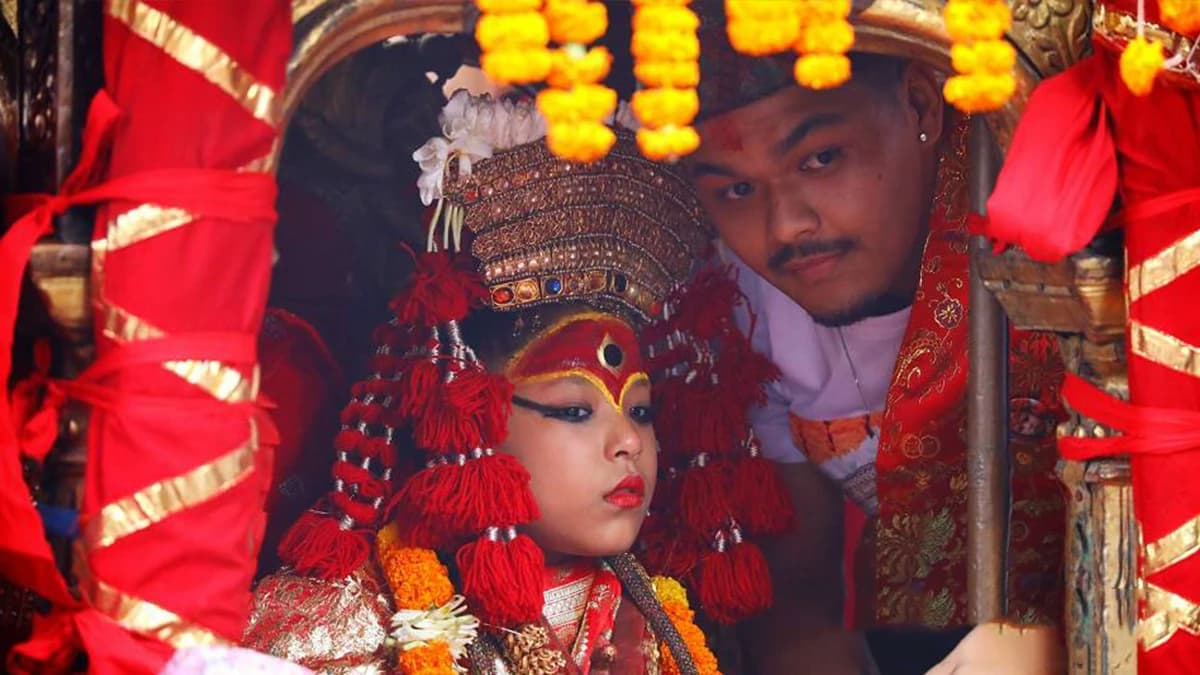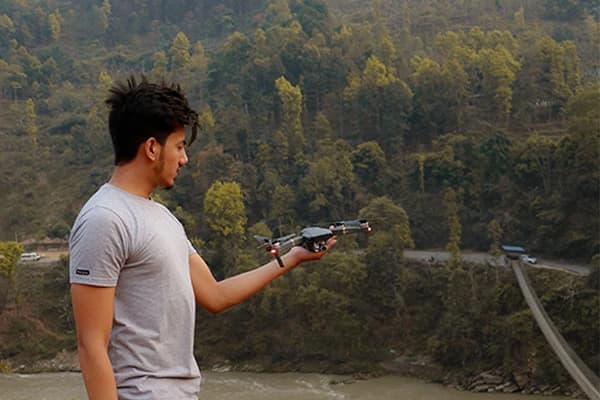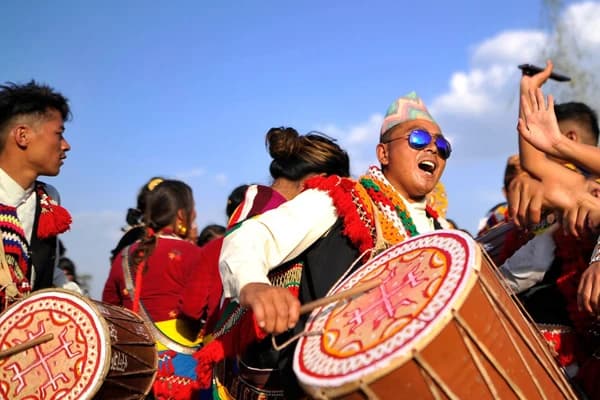History of Kumari Puja
There are various tales regarding Kumari Puja in Nepal. The most reliable and believable tale was of King Jaya Prakash Malla, the last Nepalese King of the Malla Dynasty. King Jaya Prakash Malla his friends, and Goddess Taleju Bhawani used to play tripasa, a dice game, in a secret chamber every night with the condition of not telling anyone about their meeting.
The King's wife once kidnapped Goddess Taleju when the Queen followed the King, which infuriated her. She told her that if they wanted her to protect their country and see again, then the king needed to search for a young girl whom she could reincarnate in human form and must be from the Newari (Shakya) community of Ratnawali. As a result, Jaya Prakash Malla started "Kumari Pratha" and began looking for a young girl who might be Taleju-possessed.
Likewise, another story about the disappearance of Taleju is that the Goddess used to visit King Trailokya Malla every night in human form. They used to discuss the welfare of the country while playing dice secretly in the Royal Palace. King Trailokya Malla once approached Goddess sexually, which raged her; she stopped coming to the palace. When King realized his mistake and asked her to return, the goddess agreed to appear only on the condition of appearing in the body of a young girl who must be from the Shakya family.
The third story is related to the banishment of a young girl. During King Jayaprakash Malla's reign, the young girl was boycotted from the city because of possession by the goddess Durga, which created fear in the city. When the Queen knew about her, she brought back the girl and started worshipping her as the living incarnation of Goddess Durga.
Selection of Goddess-Kumari
The selection of Goddess-Kumari began as soon as the former Kumari had a menarche. The five seniors the Chief Royal Priest, the Priest of Taleju, a royal astrologer, the Panch Buddha, and the Buddhist Bajracharya, have the right to choose the Goddess Kumari. The young girl must possess 32 Lakshyana (32 perfection) or Goddess perfection to continue further tests. Some of the Lakshyana she must have is a chest like a lion, eyelashes like a cow, body resemblance to the banyan tree, thighs like a deer, and voice that must be as soft and clear as a duck.
There shouldn't be any kind of visible scars or marks on her body, must have all 20 teeth, absence of menstruation, mustn’t be from intercaste family, and shouldn’t have had an Ihi-Bel Biha, a Newari ritual. During the Dashain festival, this test is performed in the Kalratri (9 black nights), where she has to spend a night in a room with 108 heads of buffaloes and a goat sacrificed to Goddess Kali. A few masked men try to scare her by making a scary noise and the room is lit only by candles If she doesn't get scared, then she becomes the Goddess Kumari. If she is scared, then another candidate should pass through this process until a brave young girl becomes a Kumari.
Power of Kumari-Living Goddess
Kumari, the living Goddes, has the power of Taleju Bhawani and Durga, as she is the living incarnation of the Hindu Deity. In Nepal, the Hindu or Buddhist Newar community worships Kumari. Due to her power, she is regarded as being above all others and her power makes her unique and makes it live. Her pure power, with the goddesses Taleju and Durga, makes people worship her.
Her separate identity and set of attributes have made her a unique form of human incarnation. The devotees simply worship her on normal days. During worshipping, goddess sits on the golden throne, which is located in the audience room of Kumari Ghar, and special practices of Living Goddess worship are kept secret.
Life as a Royal Kumari-Living Deity
When a young girl passes the selection process, she will be purified by tantric purification and will enter Kumari Ghar in a white dress. She is allowed to play only with the children of her caretakers, which belongs to a narrow pool of Newari culture. Kumari will always be dressed in red and gold colored clothes, she must wear her hair in a topknot with a painting of Agni Chakshu, or fire eye, on her forehead, which remarks her special power of perception.
She will be carried by her caretaker or transported in a golden palanquin, she will touch the ground for the very last time when she walks across Durbar Square. She is not allowed to touch the ground except her palace and her sacred feet will only covered in red stockings and will never wear shoes. Devotees will touch her sacred foot by believing to receive her blessing and remove the long-term illness.
Her single glimpse has so much power that it is believed to bring good fortune to one’s life. She glanced at the devotees waiting for them in the courtyard for a few seconds and only fortunate petitioner could visit the goddess in the Kumari Ghar. Goddess sits on a glided lion throne and is believed to remove problems regarding blood or menstrual disorders simply by glancing at the visitors. She is believed to have a special power over blood problems. When high-profile petitioners like King, bureaucrats, and other government officials come to visit her, she offers her feet for kissing or touching, which is an act of devotion.
When visiting Goddes Kumari, her actions are closely watched; if she cries or laughs, then the petitioner will have a serious illness that results in death; if she weeps or rubs her eyes, then the seeker will have an instant death; trembling results in a jail sentence; handclapping results in reason to fear the king; and starting to eat offered food in front of them results in financial losses. If she remains silent infront of the seeker, then she grants his/her wish. Previously, Kumaris didn't receive any education but nowadays, they can receive education with the help of private tutors. Currently, Kumaris of Bhaktapur attend a private education school.
The Sublime Navami and Dashami
The Navami and Dashami of the festival, Dashain, are very important for the Kumari. The first day of Dashain starts by placing a sacred clay Kalash in every temple and prayer room of the house. They put barley seeds as a symbol of summoning the god's spirit in the Kalash. Every morning they sprinkled water on the barley seeds and prayed the Kalash The ingrowth in the barley seed shows the intensification of Goddess, Durga's presence.
At the end of the tenth day, the fully grown sacred yellow jamara is distributed as a blessing of Goddess Durga to the family members. Goddess becomes more powerful on the ninth day, Navami, and becomes the Goddess Durga's great warrior against the demon Mahishasura. This day marks the victory of Goddess Durga and the restoration of the world, which is celebrated by sacrificing all black 108 goats and buffaloes to resemble the demon Mahishashura.
The Third Eye of Kumari
The third eye of Goddess holds spiritual as well as holistic beliefs. The third eye, also known as the fire eye, is located on the sacred part of the forehead. There is a belief that says these fire eyes can make someone burst in happiness while turning some to fire. They decorate Living Goddess with the golden eye with a black pupil, the third eye on only two occasions, Dashain or Indra Jatra.
During Dashain and Indra Jatra, Living Goddess becomes more powerful and opens the channel between Kumari Devi and the Goddess. Communicating via her third eye makes a strong connection with the goddess.
Taleju Temple (Kumari Ghar)
The Taleju Temple of the Durbar Square is commonly known as Kumari Ghar. Kumari Ghar is a residence of royal Kumari, which was built by the last king of the Malla Dynasty, Jaya Prakash Malla. The Kumari Ghar is only opened on the Nawami of Dashain festival and it is a part of the UNESCO World Heritage sites. The Kumari Ghar can have only one priest and foreigners are forbidden to enter the temple. Everyone can get a glimpse of the Goddess when visiting during the visiting hours for a few seconds.
The architecture of Kumari Ghar is famous because of its wooden carving. The fine wooden works on the windows and tympanum of different gods and goddesses are beyond the imagination. There is an image of Mahismardini Bhagawati on the tympanum of the temple, which resembles the incarnation of Devi Taleju/Mahismardini Bhagawati in Kumari. The Terracotta art, which is made of mud, is painted red on the four corners of the courtyard of Kumari Ghar. There is a famous wall painting inside the Kumari Ghar which was made in the King Jayaprakash Malla period.
Normal people cannot see this famous wall painting. Kumari Ghar marks a blend of Hindu and Buddhist pilgrimage, as both worship Kumari. Buddhists worship Living Goddess as Tara and Buddhist priests belong to the Bajracharya caste, while Karmacharya is the Hindu Priest. During late August or September, one can involved in the Indra Jatra festival by receiving a blessing from her.
The De-thronement of Kumari
Goddess Kumari is removed from the throne of living Goddess once she starts bleeding naturally. Living goddess is famous as the human symbol of power and safety of the nation. As a sole representation of the Hindu and Buddhist communities, if she shredded blood via injury, then she would no longer consider the Goddess because the goddess Taleju or Durga would escape from her body. The loss of blood from her body spoils the purity of Kumari, which results in the loss of all the divine powers.
Ex-Kumari
In Nepal, Goddess Kumaris is worshipped in places like Kathmandu, Patan, Sankhu, Bhaktapur, and Bungamati. Previously, Living Goddess was restricted from getting an education and getting married. Nowadays, Kumaris can receive education when they are not dressed as Living Goddess from a private tutor as well as by attending school, and the myth that Kumari’s future partner will have a short life span is also broken. After dethronement, Living goddess can continue a normal life like that of other people and can work and study as per their interests.
Life after Dethronment
Life after Kumari's dethronement gets completely changed. After dethronement, she will live a normal human life as a divine goddess. In Nepal, living goddess is bright outside the Kumari Ghar in only main events like Indra Jatra. More than a thousand of people come to see the chariot of Living Goddess at Indra Jatra than any other male gods. In a Patriarchal nation like Nepal, praising a female god is quite intriguing but people have accepted this tradition. People irrespective of their culture and religion respect and dedicate their time and energy, which is very unique. When living goddess is inside the Kumari Ghar, her caretaker does everything that she wants. The power of Goddess Taleju is inside her body, which will escape if she shreds blood via any physical or biological means.
The day she shreds blood, she will be a normal human and has to perform the gufa or Baarha ritual. In the Newar community, there is a tradition of keeping a girl in gufa when she hits puberty, which marks her transition to womanhood. She will spend 12 days inside a dark room, avoiding the rays of sunlight and the sight of male family members like her brother and father. After 12 days, the young girl is taken out of the darkroom/Gufa and marks the day via a grand celebration with the family members. Her mother will help her untie her topknot hair, remove eyeliner, and have fire-eye painted on her forehead in a riverside. Then, after the ceremony, she will live like normal human beings.
Kumari Jatra
Kumari Jatra is a part of Indra Jatra, which falls annually in September. Both the Hindu and Buddhist communities of Kathmandu celebrate Indra Jatra. It is one of the most popular festivals in Nepal. During Kumari Jatra, Living goddess is dressed up in a red dress with full face makeup and her special third eye. She will step outside the Kumari Ghar via Golden Palanquin and many devotees will come here to seek her blessing.
Two chariots of Ganesh and Bhairav will follow the Kumari, a living goddess chariot. Indra Jatra is celebrated for eight days where masked dancer called Lakhey show their Lakhey dance on every corner of the streets. Loud drums accompany their dance. The last day of Kumari Jatra is ended by giving a blessing to a high profile like the President (a King in the past). Kumari will put a red Tika on their forehead, which was started by the late king Jayaprakash Malla during his regime.
FAQ of Living Goddess-Kumari
Kumari is the living goddess worshipped in Nepali communities. Kumari, also known as Kumari Devi or the Living Goddess, is possessed by the Goddess Taleju or Durga. When the young girl is only 2 to 3 years old, five seniors choose Kumari. The word Kumari comes from Saksrit, which means princess.
- Are Kumari allowed to marry?
Yes, Kumari is allowed to marry. There was a myth that if ex-Kumari got married, her husband would die, making her a widow but this myth is broken now. In the past, the Kumaris were restricted from getting an education due to superstitious beliefs but nowadays living goddess even attend private school.
- What are the 32 requirements to be a Kumari?
Living goddess is selected if she possesses all the physical 32 Perfection. These 32 perfection only allow her to do further tests, they are:
-
Virgin
-
Body like a Banyan Tree (Nyagrodha)
-
Eyelashes like Cow
-
A broad forehead
-
Neck like a conch shell
-
No blemishes,
-
moles, or Birthmarks
-
Chest like a lion
-
Body formed like a Saptacchata Leaf
-
Voice soft and clear as of a duck
-
Same horoscope as of the King
-
Round shoulders
-
No bad body odor
-
Perfectly shaped teeth
-
Sign of Serenity and Fearlessness
-
A well-formed heel
-
Black Straight Hair and Dark Eyes
-
Delicate and Soft hands and feet
-
Thighs like those of a deer Small and moist tongue
-
Sexual Organs are small and well-recessed
The five senior Buddhist Bajracharya: Chief Royal Priest, the Priest of Taleju, a royal astrologer, and the Priest of Taleju are responsible for selecting the Goddess Kumari.
- What happens to Kumari after puberty?
The Goddess Kumari loses her divine power as soon as she attains puberty. The biological blood loss from living goddess indicates that Taleju or Durga will leave her body and she will become a normal human being. Kumari Pratha is dominant in towns like Patan, Bhaktapur, Bungamati, Thimi, and Kathmandu.
- Is Kumari Pratha violating child rights?
No, Kumari Pratha is not violating child rights. In Nepal, there is an ongoing debate between human rights and child rights advocates that the strict rule of the living goddess made her restrict her human rights. This resulted in access to education via private tutors, use of the internet, books, and magazines, giving national exams while being observed, and so on.
- Why does Goddess Kumari don't smile?
Goddess Kumari doesn’t smile because if she smiles, it will be bad luck, while her fierce look denotes good luck.
- Who was the first Royal Kumari of Nepal?
The first Royal living goddess of Nepal was Preeti Shakya. In 2001, she became a royal Kumari at the age of three. She served as a royal Kumari for eight years.
- Who is the oldest Kumari in Nepal?
The oldest living goddess of Nepal is Miss Dhana Kumari Bajracharya. She was chosen as Kumari when she was only 2 years old in 1954 AD. She is in her mid-70s and is still following the Kumari lifestyle because she never got her menstruation. She was selected from Patan.
- Who is the current Kumari in Nepal?
The current Kumari of Nepal is Trishna Shakya. On September 27, 2017, she became the royal living goddess of Nepal. She was only three years old at the time of selection.





